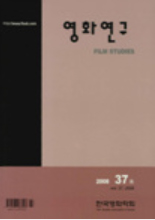- 영문명
- A Comparative Analysis about the Community and Filial Piety as Shown in the Goryeojang and The Ballad of Narayama
- 발행기관
- 한국영화학회
- 저자명
- 이효인
- 간행물 정보
- 『영화연구』제37호, 273~299쪽, 전체 27쪽
- 주제분류
- 예술체육 > 예술일반
- 파일형태
- 발행일자
- 2008.09.30
6,040원
구매일시로부터 72시간 이내에 다운로드 가능합니다.
이 학술논문 정보는 (주)교보문고와 각 발행기관 사이에 저작물 이용 계약이 체결된 것으로, 교보문고를 통해 제공되고 있습니다.

국문 초록
영문 초록
The present thesis involved the The Ballad of Narayama(1958) by Kinosita Keisuke, the Goryeojang(1963) by Kim Gi-young and the The Ballad of Narayama(1982) by Imamura Syohei, to compare the movie's description about the community and the filial piety. For this purpose, a basic study was carried out about the trends of the works by the three directors, about the social environments when the movies were released, and also about the 'Giro story'. The result showed that Japan in 1958, Korea in 1963 and Japan in 1982 had unique social characteristics, and that the ‘Giro story’ was widespread from India to all over the eastern Asia. The movies of the three directors, which have similar subjects and themes as well as similar background stories, however, were different from one another according to the director's view of the world. Regarding ‘community’ and ‘filial piety’, the three works said as follows: As to the issue of the community, the director Kinosita thought that only the spirit of community could overcome the severe poverty, based on the postwar experience of resolving the problems of disorder and poverty, achieving the economic growth; while the director Imamura took the community as 'a complex place with a minimum role' On the other hand, Kim Gi-yeong described the community as an object which was threatening or was to be overcome. As to the issue of the filial piety also, the director Kinosita considered the filial piety as a subordinate concept to the community's group, as a personal emotion of love and sorrow; while the director Imamura Syohei seemed to consider the filial friendship as the practical pathos (the source of haman mind) which goes beyond personal level to overcome social regulations while accepting the futility of life. To Kim Gi-young, the community seemed to be an oppressive order that did not allow the filial piety, in the situation of the collision between filial piety and community. Through this research it was found that the directors took similar themes or subjects with different views, so a comparative study was attempted on the Korean and Japanese movies.
목차
1. 서론
2. 기초 연구
3. 내러티브 비교 분석
4. 〈나라야마 부시코〉, 〈고려장〉, 〈나라야마 부시코〉의 공동체 및 효(孝)에 대한 입장 차이
5. 맺음말
키워드
해당간행물 수록 논문
- 인도 마살라 영화의 특징 분석
- <고려장>과 <나라야마 부시코>(1958, 1982)에 나타난 공동체 및 효(孝)에 대한 비교 분석
- 매체 다원화 시대 다큐멘터리 장르의 경계에 관한 연구
- 사이버소설 각색영화의 스토리텔링과 문화콘텐츠
- 사단법인 한국영화학회 정관 외
- 영화제작에서 가상 세트와 디지털 스튜디오의 기술 변화 연구
- <8과 2분의 1>과 <바톤핑크>의 3막 구조 연구
- 디지털 시대의 문화적 실천과 영화
- 전 지구화의 대중문화, 한류 담론과 한국영화산업의 동아시아 진출
- 우리영화 심의제도에 대한 논의
- <맥베스>의 마녀 장면
- 북한영화의 탄생과 주인규
- 1910년대 전반기 식민지 조선에서의 활동사진에 관한 연구
- 한국영화 산업 클러스터 정책 연구
- <뮈리엘 혹은 회귀의 시간>에 나타난 기억의 연구
- 한국 영화비평의 정치적 무의식에 대한 연구
- 아방가르드 영화의 미학과 유희적 모더니즘
참고문헌
관련논문
예술체육 > 예술일반분야 BEST
- 생성형 AI 도구와 디자이너의 협업 프로세스 개발 - 이미지를 통한 아이디어 확산에서 고해상도 렌더링까지
- 청소년기의 치료레크리에이션 프로그램을 적용한 디지털 디톡스(Digital Detox) 효과성 연구
- ‘일과 삶의 균형(Work-Life Balance)’ 척도 개발을 위한 연구
예술체육 > 예술일반분야 NEW
- Z세대 생활체육 동호인들의 SNS 중독 경향성과 불안정 성인애착이 완벽주의적 자기제시 및 우울에 미치는 영향
- 즐거움과 몰입을 통한 수익성 기대가 NFT 구매 의도에 미치는 매개효과 분석: UTAUT2와 합리적 무관심(RI)을 중심으로
- 생태체험이 청소년의 자연친밀감, 환경태도, 환경행동의도에 미치는 영향
최근 이용한 논문
교보eBook 첫 방문을 환영 합니다!

신규가입 혜택 지급이 완료 되었습니다.
바로 사용 가능한 교보e캐시 1,000원 (유효기간 7일)
지금 바로 교보eBook의 다양한 콘텐츠를 이용해 보세요!



